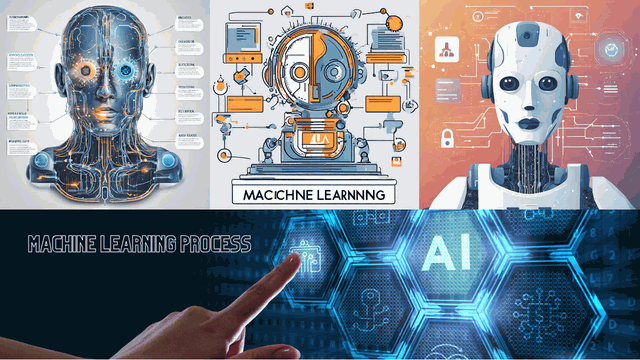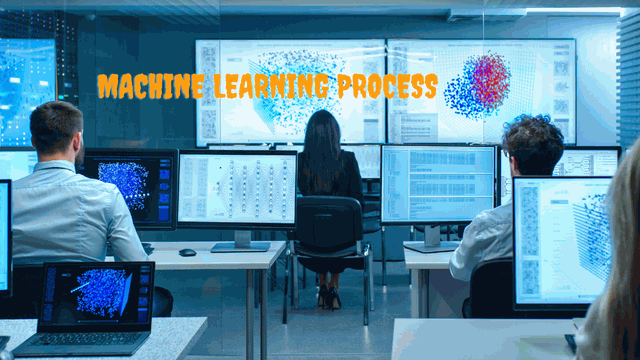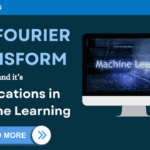Machine Learning Process: From Data to Prediction
Preface
Data scientists and machine learning experts use a set of steps known as the machine learning process to build and train models that can predict or take actions without explicit programming. A subfield of artificial intelligence known as machine learning enables computers to discover patterns and make decisions without explicit programming.

It has uses in a wide range of fields, such as marketing, finance, and healthcare. Each essential step in the machine learning process is essential to creating powerful models.
The stages of the machine learning process will be thoroughly examined in this editorial.
- Data selection
- Data preprocessing
- Splitting data
- Algorithm implementation
- Evaluation
- Feature engineering
- Visualization
- Hyperparameters
1. Data selection
Data selection is an important stage in the data pretreatment pipeline, especially when doing machine learning and data analysis activities. It entails selecting and extracting pertinent data from a larger dataset to ensure that only the most relevant information is used for subsequent analysis or modeling. The following are the steps in data selection:
◊ Define your goal:
Declare the problem or research question you’re attempting to solve. This will assist you in leading the selection process by identifying the exact traits or variables you require.
◊ Determine the important variables:
Determine which traits or attributes are required to achieve your goal. Remove any variables that are useless or duplicated.
◊ Establish criteria for inclusion and exclusion:
Establish criteria for incorporating and deleting data points. You may, for example, define a time range, a geographic area, or any other relevant filters.
◊ Identification of the Data Source:
Determine the data sources that contain the required variables. This could be databases, spreadsheets, APIs, web scraping, and so on.
◊ Data Gathering:
Gather information from the identified sources. This could include accessing databases, importing spreadsheets, or retrieving data via APIs.
◊ Sampling of data (if applicable):
If your dataset is too large, consider employing sampling techniques to reduce the size while keeping a representative sample of the population.
◊ Cleaning Data:
Perform basic data cleaning before selection to handle missing numbers, delete duplicates, and address any other data quality issues.
◊ Filters and conditions should be used:
Select the data points that fit your inclusion requirements using any predetermined criteria or filters. If you’re dealing with a time series, for example, you may provide a certain time range.
◊ Check the data integrity:
Check that the data you’ve chosen is consistent with the criteria and objectives you’ve set. This phase is critical for ensuring the data’s integrity and quality.
◊ Record the selection process:
Keep track of the steps you took for data selection. This documentation is useful in terms of reproducibility and transparency.
◊ Keep Selected Data:
Save the selected data in a structured format for additional analysis or modeling (e.g., CSV, Excel, and database).
◊ Validation of data and quality assurance:
Conduct a final evaluation of the chosen data to ensure that it fulfills the required quality requirements and is appropriate for the intended analysis.

2. Data Preprocessing
Data preprocessing is an important stage in the pipeline of data preparation for machine learning and data analysis jobs. It entails cleaning, converting, and organizing raw data so that it can be used effectively for modeling. The following are some common steps in data preprocessing:
◊ Cleaning Data:
Imputation (replacing missing values with approximated values) or elimination of rows or columns with missing data can be used to handle missing values.
◊ Transformation of data:
Data normalization, or standardization, is the process of scaling features to a similar range to avoid issues with algorithms that are sensitive to the magnitude of data.
◊ Encoding category variables:
The process of converting category data into numerical data can be accomplished using techniques such as one-hot encoding or label encoding.
◊ Data compression:
Dimensionality reduction refers to techniques such as principal component analysis (PCA) or feature selection approaches that are used to reduce the number of features while maintaining essential information.
◊ Imbalanced Data Handling:
Oversampling, under sampling, and the use of specialist algorithms developed for imbalanced data are examples of these techniques.
◊ Dealing with Noisy Data:
Identifying and eliminating noise or irrelevant information that may impair model performance
◊ Data division:
To evaluate the model’s performance, divide the dataset into training, validation, and test sets.
◊ Scaling Data:
Scaling numerical features to ensure they are scaled similarly is critical for algorithms such as support vector machines and neural networks.
◊ Preprocessing of Time Series Data:
Managing temporal issues such as seasonality, patterns, and lags lags
◊ Text Data Preparation:
Natural language processing tasks include tokenization, stop word removal, and stemming/lemmatization.
◊ Handling inaccurate data:
Transforming the target variable to follow a normal distribution might be advantageous for some algorithms, particularly in regression problems.
◊ Managing Multimodal Data:
Ensure that date and time representations are consistent.
3. Splitting Data
Splitting data is an important step in machine learning and data analysis. It entails splitting a dataset into two or more sections for training and testing. The following are the most common splits:
◊ Set of Instructions:
- This data set is used to train the machine learning model. From this set, the model learns patterns, relationships, and features.
- It is usually the largest element, accounting for 70–80% of the total data.
◊ Set of Validations:
- This set is used to fine-tune the hyperparameters of the model. It functions as a distinct test set from the final evaluation.
- It prevents overfitting by allowing the model to be evaluated on data that it did not observe during training.
- It is typically between 10 and 15% of the entire dataset.
◊ Set of tests:
This collection is used to provide an unbiased assessment of a final model fit on training data. It is a method of simulating how the model will behave on new, previously unseen data.
It should be kept completely independent of the training and validation sets.
It accounts for approximately 10–15% of overall data. The split ratio (e.g., 70-15-15) can vary depending on the individual situation, the amount of data available, and the model’s complexity. A larger training set may be employed when there is a lot of data.
4. Algorithm Implementation
Algorithm implementation entails translating a given algorithmic technique or logic into a specific programming language. Here’s a general overview of how to implement algorithms:
◊ Recognize the algorithm:
Make sure you completely grasp the algorithm before you begin coding. Read about it, analyze its pseudo-code (if accessible), and understand its reasoning.
◊ Choosing a Programming Language:
Choose a programming language with which you are familiar. Some languages are better suited for specific types of algorithms; however, the majority of computer languages can handle a wide variety of algorithms.
◊ Optional pseudocode:
Write the algorithm in pseudocode if it isn’t provided in code form. Pseudo code is a method of representing an algorithm in a human-readable format that can then be converted into actual code.
◊ Dissect the algorithm:
Break the algorithm down into smaller, more manageable steps. This simplifies implementation and debugging.
◊ Begin coding:
Begin writing code depending on your comprehension of the algorithm. Begin with the first step and work your way through the rest.

5. Evaluation
Evaluation is a vital phase in the machine learning process that analyzes the performance and generalization capabilities of a trained model on new, unseen data. It aids us in determining how effectively the model will perform in real-world circumstances.
Here are some important characteristics of machine learning evaluation:
◊ Data Distribution for Training and Testing:
Typically, the dataset is separated into two parts: training data and testing data. The model is trained using training data and then tested using testing data.
◊ Choosing Metrics:
The proper assessment metric relies on the type of problem (classification, regression, etc.) and the model’s specific aims. Accuracy, precision, recall, F1-score for classification, mean absolute error (MAE), mean squared error (MSE), and R-squared for regression are all common metrics.
◊ Consideration for Bias and Fairness:
To ensure fairness and eliminate biases, the model’s performance should be evaluated across different subgroups. In a classification task, for example, you could wish to see if the model performs equally well for different demographic groups.
◊ Optional cross-validation:
Cross-validation is the process of dividing data into numerous subsets (folds), training the model on some of them, and then evaluating it on the remaining fold. This aids in obtaining a more reliable estimate of the model’s performance.
◊ Model Selection and Hyperparameter Optimization
On the same data, different models and hyperparameters may perform differently. Evaluation aids in the comparison of models and the selection of the best-performing one.
◊ Under-fitting and over-fitting:
Evaluation can help determine whether a model is overfitting (performing well on training data but badly on test data) or underfitting (performing poorly on both training and test data).
◊ Plots and visualizations:
ROC curves, precision-recall curves, and learning curves, for example, might provide insight into how well the model is working.
◊ Explain ability and interpretability:
It is critical to understand why a model makes specific predictions. Techniques such as SHAP values, LIME, and feature importance can aid in the interpretation of the model’s decisions.
◊ Considerations for Deployment:
The findings of the evaluation can help determine whether the model is ready for deployment. Before deploying a model in real-world applications, specific performance thresholds must be met.

6. Feature engineering
A critical phase in the machine learning process is feature engineering. It entails adding new features to your dataset or modifying existing ones to improve the performance of your machine-learning models. A well-designed feature set can considerably improve the predictive ability of your models.
Here are some common feature engineering methodologies and concepts:
◊ Handling Values That Are Missing:
Fill in missing values via techniques such as mean, median, mode, or more advanced algorithms such as K-Nearest Neighbors (KNN) imputation.
◊ Indicator Variables:
Create binary flags that indicate whether or not a value is missing.
◊ Categorical Variable Encoding:
Convert categorical variables to binary vectors via one-hot encoding. Label encoding is the process of converting category information into numerical labels.
◊ Embedding:
In lower-dimensional continuous space, represent categorical variables.
◊ Binning/Discretization:
To decrease noise and capture non-linear correlations, group continuous data into bins or categories.
◊ Normalization and Scaling:
Scale features to have a zero mean and a unit variance.
Scale features to a given range (for example, [0, 1).
◊ Robust Scaling:
To handle outliers, scale features using robust statistics.
◊ Transformations:
To make the data more regularly distributed, logarithmic, exponential, and Box-Cox transformations can be used.
◊ Developing Interaction Terms:
Combine two or more elements to identify probable interactions for the target variable.
◊ Time-based characteristics:
Time stamps can be used to extract information such as the day of the week, month, quarter, and so on.
◊ Domain-Specific Characteristics:
Make use of domain expertise to design features that are pertinent to the issue at hand.
◊ Feature Choice:
To choose the most significant characteristics, use strategies such as univariate selection, recursive feature removal, or tree-based algorithms.
◊ Reduced Dimensionality:
To minimize the dimensionality of the feature space, techniques such as principal component analysis (PCA) or t-distributed stochastic neighbor embedding (t-SNE) might be utilized.
◊ Text Information Processing:
Text data processing techniques such as tokenization, stop word elimination, stemming, and others
◊ Handling Highly Correlated Features:
To reduce multicollinearity, remove one of the strongly correlated features.
◊ Data Aggregation:
Aggregate information over time periods or regions for time series or geographical data.
◊ Image Feature Extraction:
Techniques for transfer learning include edge detection, texture analysis, and the use of pre-trained convolutional neural networks.
◊ Importance of Features:
Use model-specific strategies (such as feature importance in tree-based models) to determine which characteristics are most informative.
◊ Tree Feature Engineering:
One-hot encoding may not be necessary for tree-based models, and numerical encoding may be preferable.

7. Visualization
Visualization is an important component of the machine learning process. It aids in data comprehension, pattern recognition, and model performance evaluation. Here are a few crucial points where visualization is important in the machine-learning process:
◊ EDA (Exploratory Data Analysis):
Before going into modeling, it is critical to investigate and comprehend the dataset. Histograms, box plots, scatter plots, and correlation matrices are examples of visualization approaches that can provide insights into the distribution, correlations, and potential outliers in data.
◊ Feature Selection and Engineering:
Visualizations can assist in identifying significant model characteristics. Heat maps, pair plots, and scatter plots, for example, can highlight correlations between features and their impact on the target variable.
◊ Data Preprocessing and Cleaning:
Visualizing missing data, outliers, and skewed distributions can help you decide how to proceed with data preprocessing. This may entail filling in missing values, altering features, or deleting outliers.
◊ Dimensionality Reduction:
Techniques such as principal component analysis (PCA) or t-SNE can be used to reduce data dimensionality while retaining critical properties. Visualization tools can aid in the comprehension of modified data.
◊ Model Training and Evaluation:
In the case of deep learning, visualizing model training and evaluation metrics over epochs can reveal insights into the learning process. ROC curves, precision-recall curves, and confusion matrices can also be used to evaluate model performance.
◊ Model Interpretability:
Techniques such as SHAP (Shapley Additive Explanations) values, LIME (Local Interpretable Model-Agnostic Explanations), and feature importance charts can aid in reading complex model predictions.
8. Hyperparameters
Hyperparameter tuning is a crucial step in the machine-learning process that involves finding the best set of hyperparameters for a given model. Hyperparameters are configuration settings for a model that are not learned from the data but must be set before the training process begins. Examples include the learning rate in a neural network, the depth of a decision tree, or the number of clusters in a K-means clustering algorithm.
Here are steps you can follow for hyperparameter tuning:
Identify which hyperparameters you wish to tune and define a range of values or distributions for each. In a neural network, for example, you could wish to tweak the learning rate, regularization intensity, and number of hidden layers.
Select a tuning strategy.

◊ Grid Search:
This entails analyzing all hyperparameter combinations on a predetermined grid. It is comprehensive, but it can be computationally expensive.
◊ Random Search:
This method involves sampling hyperparameter combinations at random. It is more efficient than grid search and can frequently find good results more quickly.
◊ Bayesian Optimization:
A more sophisticated technique that models the relationship between hyperparameters and model performance allows for more intelligent searching.
◊ Divide your dataset into three parts:
Training, validation, and testing The training set is used to train the models, the validation set is used to evaluate performance during hyperparameter tweaking, and the test set is used to provide an unbiased evaluation at the conclusion.
◊ Choose a performance statistic.
Select a statistic that accurately reflects the success of your model. Depending on the problem, it could be accuracy, mean squared error, F1-score, or something else.
◊ Conduct a search hyperparameter combination:
On the training set, train the model. Using the specified metric, assess its performance on the validation set. Keep track of how each set of hyperparameters performs.
◊ Choose the best model:
When the search is finished, select the model that performed the best on the validation set.
◊ Test Set Evaluation:
After deciding on the optimal model, assess its performance on the test set to obtain an impartial estimate of its generalization capabilities.
◊ Complete the model:
Train the model using the optimal hyperparameters on the complete dataset (training and validation), then consider deploying it for real-world applications.
◊ Keep an eye out for overfitting:
Keep an eye on how the model performs in real-world scenarios. If it isn’t operating as intended, you may need to re-tune the hyperparameters.
Conclusion
These are the main steps of the machine learning process. Furthermore, strategies such as cross-validation, early halting, and regularization can supplement hyperparameter tuning efforts and contribute to the development of improved models.
FAQs
1. What is Machine Learning?
Machine learning is a subset of artificial intelligence that focuses on the development of algorithms and models that enable computers to learn from and make predictions or decisions based on data.
2. What are the key steps in the machine learning process?
The key steps in the machine learning process typically include data collection, data preprocessing, model selection, model training, model evaluation, and deployment.
3. What is data preprocessing?
Data preprocessing involves cleaning, transforming, and organizing raw data into a format suitable for training a machine learning model. It might involve activities like handling missing values, scalability, and categorization of variables.
4. What does a machine learning model mean?
The relationship between the input features and the target variable is captured by a model, which is a mathematical representation. In order to make predictions or decisions, it is trained on data.
5. How do you select an algorithm for machine learning?
The kind of problem (classification, regression, etc.), the size and complexity of the dataset, and the particular needs of the application all influence the algorithm that is chosen.
6. What is the tuning of hyperparameters?
Finding the ideal combination of hyperparameters (such as learning rate and regularization strength) to optimize a model’s performance is known as hyperparameter tuning.
7. Why is feature engineering necessary?
Adding new features or altering existing ones to improve a model’s functionality is known as feature engineering. It might be necessary to extract pertinent information from the data.
8. How is the evaluation of a machine learning model done?
Common evaluation metrics include accuracy, precision, recall, F1-score for classification, and mean squared error for regression. The best metric to use depends on the specific problem.
Get access all prompts: https://machine.com/xyz







